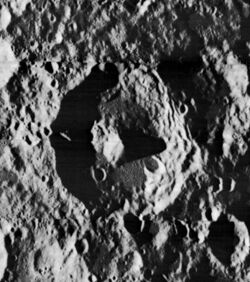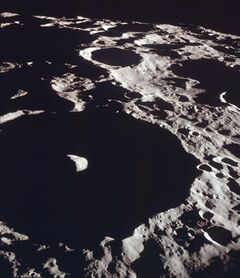Icarus (crater)
Topic: Astronomy
 From HandWiki - Reading time: 3 min
From HandWiki - Reading time: 3 min
 Lunar Orbiter 2 image | |
| Diameter | 96 km |
|---|---|
| Depth | Unknown |
| Colongitude | 174° at sunrise |


Icarus is a lunar impact crater that lies on the Moon's far side. It is located to the west of the huge walled plain Korolev, and less than two crater diameters to the east of the crater Daedalus. To the south of Icarus is the smaller Amici.
Icarus has a worn rim and a relatively wide inner wall. A small crater lies across the southern rim, and the side bulges outward slightly along the southwestern face. There is a disproportionately tall central peak located near the crater midpoint. This rise is unusual in that it is taller than the outer rim; most peaks are only about half the crater depth. The remainder of the floor is relatively flat in the eastern half and slightly more irregular to the west.
Icarus was named by the Apollo 15 crew. Composer Ralph Towner made a tune called Icarus which was released in an album of the Paul Winter consort. One member of the consort was cellist David Darling, whose brother-in-law was astronaut Joseph P. Allen. Allen served as mission scientist while a member of the astronaut support crew for Apollo 15. He gave the Apollo 15 crew a tape of the Paul Winter consort. the Apollo 15 crew named two moon craters after Ralph Towner's compositions "Ghost Beads" and "Icarus".[1][2]
Satellite craters
By convention these features are identified on lunar maps by placing the letter on the side of the crater midpoint that is closest to Icarus.
| Icarus | Latitude | Longitude | Diameter |
|---|---|---|---|
| D | 4.3° S | 171.2° W | 68 km |
| E | 5.2° S | 168.8° W | 12 km |
| H | 7.8° S | 169.4° W | 32 km |
| J | 7.3° S | 170.9° W | 32 km |
| Q | 7.8° S | 176.2° W | 41 km |
| V | 3.9° S | 176.0° W | 36 km |
| X | 2.2° S | 175.5° W | 43 km |
References
- ↑ "The Consort". http://www.paulwinter.com/the-consort/.
- ↑ "Now he's over the moon about Icarus" (in en). The Sydney Morning Herald. 2002-11-25. https://www.smh.com.au/entertainment/music/now-hes-over-the-moon-about-icarus-20021125-gdfv4m.html.
- Wood, Chuck (February 12, 2007). "A Really Tall Peak". Lunar Photo of the Day. http://www2.lpod.org/wiki/February_12,_2007.
- Andersson, L. E.; Whitaker, E. A. (1982). NASA Catalogue of Lunar Nomenclature. NASA RP-1097.
- Blue, Jennifer (July 25, 2007). "Gazetteer of Planetary Nomenclature". USGS. http://planetarynames.wr.usgs.gov/.
- Bussey, B.; Spudis, P. (2004). The Clementine Atlas of the Moon. New York: Cambridge University Press. ISBN 978-0-521-81528-4.
- Cocks, Elijah E.; Cocks, Josiah C. (1995). Who's Who on the Moon: A Biographical Dictionary of Lunar Nomenclature. Tudor Publishers. ISBN 978-0-936389-27-1. https://archive.org/details/isbn_9780936389271.
- McDowell, Jonathan (July 15, 2007). "Lunar Nomenclature". Jonathan's Space Report. http://host.planet4589.org/astro/lunar/.
- Menzel, D. H.; Minnaert, M.; Levin, B.; Dollfus, A.; Bell, B. (1971). "Report on Lunar Nomenclature by the Working Group of Commission 17 of the IAU". Space Science Reviews 12 (2): 136–186. doi:10.1007/BF00171763. Bibcode: 1971SSRv...12..136M.
- Moore, Patrick (2001). On the Moon. Sterling Publishing Co.. ISBN 978-0-304-35469-6. https://archive.org/details/patrickmooreonmo00patr.
- Price, Fred W. (1988). The Moon Observer's Handbook. Cambridge University Press. ISBN 978-0-521-33500-3.
- Rükl, Antonín (1990). Atlas of the Moon. Kalmbach Books. ISBN 978-0-913135-17-4.
- Webb, Rev. T. W. (1962). Celestial Objects for Common Telescopes (6th revised ed.). Dover. ISBN 978-0-486-20917-3. https://archive.org/details/celestialobjects00webb.
- Whitaker, Ewen A. (1999). Mapping and Naming the Moon. Cambridge University Press. ISBN 978-0-521-62248-6.
- Wlasuk, Peter T. (2000). Observing the Moon. Springer. ISBN 978-1-85233-193-1.
 |
 KSF
KSF